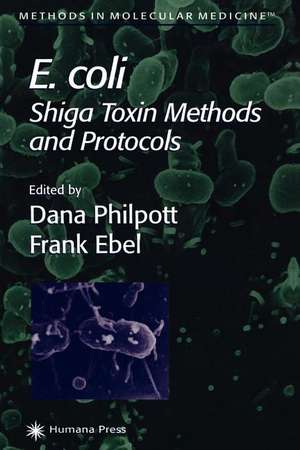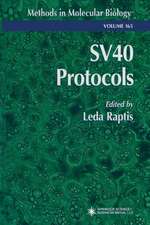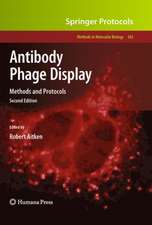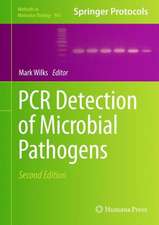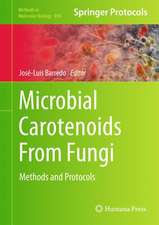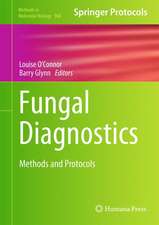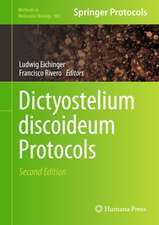E. coli: Shiga Toxin Methods and Protocols: Methods in Molecular Medicine, cartea 73
Editat de Dana Philpott, Frank Ebelen Limba Engleză Paperback – 8 oct 2011
Toate formatele și edițiile
| Toate formatele și edițiile | Preț | Express |
|---|---|---|
| Paperback (1) | 946.87 lei 43-57 zile | |
| Humana Press Inc. – 8 oct 2011 | 946.87 lei 43-57 zile | |
| Hardback (1) | 953.82 lei 43-57 zile | |
| Humana Press Inc. – 26 sep 2002 | 953.82 lei 43-57 zile |
Din seria Methods in Molecular Medicine
- 5%
 Preț: 1278.74 lei
Preț: 1278.74 lei - 15%
 Preț: 655.78 lei
Preț: 655.78 lei - 5%
 Preț: 1106.50 lei
Preț: 1106.50 lei - 5%
 Preț: 727.44 lei
Preț: 727.44 lei - 5%
 Preț: 1108.72 lei
Preț: 1108.72 lei - 15%
 Preț: 650.55 lei
Preț: 650.55 lei - 5%
 Preț: 735.66 lei
Preț: 735.66 lei - 18%
 Preț: 947.35 lei
Preț: 947.35 lei - 18%
 Preț: 948.92 lei
Preț: 948.92 lei - 5%
 Preț: 1114.54 lei
Preț: 1114.54 lei - 5%
 Preț: 1114.91 lei
Preț: 1114.91 lei - 15%
 Preț: 658.55 lei
Preț: 658.55 lei - 5%
 Preț: 734.01 lei
Preț: 734.01 lei - 5%
 Preț: 1111.61 lei
Preț: 1111.61 lei - 5%
 Preț: 1104.32 lei
Preț: 1104.32 lei - 5%
 Preț: 723.21 lei
Preț: 723.21 lei - 5%
 Preț: 1106.13 lei
Preț: 1106.13 lei - 5%
 Preț: 723.05 lei
Preț: 723.05 lei - 5%
 Preț: 1108.35 lei
Preț: 1108.35 lei - 5%
 Preț: 723.42 lei
Preț: 723.42 lei - 5%
 Preț: 1115.65 lei
Preț: 1115.65 lei - 5%
 Preț: 786.86 lei
Preț: 786.86 lei - 5%
 Preț: 1133.01 lei
Preț: 1133.01 lei - 5%
 Preț: 1114.71 lei
Preț: 1114.71 lei
Preț: 946.87 lei
Preț vechi: 1154.72 lei
-18% Nou
Puncte Express: 1420
Preț estimativ în valută:
181.18€ • 189.68$ • 149.92£
181.18€ • 189.68$ • 149.92£
Carte tipărită la comandă
Livrare economică 07-21 aprilie
Preluare comenzi: 021 569.72.76
Specificații
ISBN-13: 9781617372643
ISBN-10: 1617372641
Pagini: 364
Ilustrații: XII, 352 p.
Dimensiuni: 152 x 229 x 19 mm
Greutate: 0.49 kg
Ediția:2003
Editura: Humana Press Inc.
Colecția Humana
Seria Methods in Molecular Medicine
Locul publicării:Totowa, NJ, United States
ISBN-10: 1617372641
Pagini: 364
Ilustrații: XII, 352 p.
Dimensiuni: 152 x 229 x 19 mm
Greutate: 0.49 kg
Ediția:2003
Editura: Humana Press Inc.
Colecția Humana
Seria Methods in Molecular Medicine
Locul publicării:Totowa, NJ, United States
Public țintă
ResearchCuprins
The Medical Significance of Shiga Toxin-Producing Escherichia coli Infections.- Methods for Detection of STEC in Humans.- Serological Methods for the Detection of STEC Infections.- Detection and Characterization of STEC in Stool Samples Using PCR.- Molecular Typing Methods for STEC.- STEC in the Food Chain.- STEC as a Veterinary Problem.- Cellular Microbiology of STEC Infections.- Analysis of Pathogenicity Islands of STEC.- Generation of Isogenic Deletion Mutants of STEC.- Generation of Monoclonal Antibodies Against Secreted Proteins of STEC.- Microscopic Methods to Study STEC.- Detection and Characterization of EHEC-Hemolysin.- Shiga Toxin Receptor Glycolipid Binding.- Methods for the Purification of Shiga Toxin 1.- Methods for the Identification of Host Receptors for Shiga Toxin.- Shiga Toxin B-Subunit as a Tool to Study Retrograde Transport.- Measuring pH Within the Golgi Complex and Endoplasmic Reticulum Using Shiga Toxin.- Detection of Shiga Toxin-Mediated Programmed Cell Death and Delineation of Death-Signaling Pathways.- Interaction of Shiga Toxin with Endothelial Cells.- Shiga Toxin Interactions with the Intestinal Epithelium.- Protocols to Study Effects of Shiga Toxin on Mononuclear Leukocytes.- Animal Models for STEC-Mediated Disease.- Gnotobiotic Piglets as an Animal Model for Oral Infection with O157 and Non-O157 Serotypes of STEC.- Bovine Escherichia coli O157:H7 Infection Model.
Recenzii
"The authors should be thanked for providing this valuable resource tool that is highly recommended to microbiologists, molecular biologists and to all who are interested in bacterial toxin action. All medical libraries should house a copy of this text. The book also will serve as an excellent teaching guide for students and fellows particularly in postgraduate programs." -Folia Microbiologica
Textul de pe ultima copertă
Shiga toxin-producing Escherichia coli (STEC) and its isolated cytotoxin (Stx), also known as "hamburger E. coli" are continuing sources of significant-and sometime fatal-human and animal infections. In E. coli: Shiga Toxin Methods and Protocols, a multidisciplinary panel of leading experimentalists details the key protocols for the diagnosis and study of STEC and Stx pathogenesis. Described in step-by-step detail, these readily reproducible techniques range from those for the diagnosis and detection of STEC bacteria in patient and animal samples, to those for studying the cellular microbiology of STEC infections, especially host-pathogen interactions and the hemolysin of STEC. There are also protocols for studying the details of Shiga toxin (Stx) biology-from the purification of the toxin to the effects of Stx on various host cell functions-and for exploring STEC-mediated disease in various animal models. Each protocol has been thoroughly tested and optimized to produce robust and successful experimental results, and includes troubleshooting tips, advice on avoiding pitfalls, and alternate methods.
Comprehensive and up-to-date, E. coli: Shiga Toxin Methods and Protocols offers bacteriologists and medical microbiologists today's most powerful tools for illuminating the molecular and cellular microbiology of STEC's bacterial pathogenesis, as well as the mechanisms of its toxicity.
Comprehensive and up-to-date, E. coli: Shiga Toxin Methods and Protocols offers bacteriologists and medical microbiologists today's most powerful tools for illuminating the molecular and cellular microbiology of STEC's bacterial pathogenesis, as well as the mechanisms of its toxicity.
Caracteristici
Includes supplementary material: sn.pub/extras
